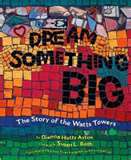 When I see the words “O beautiful for spacious skies”, I automatically sing in my head “for amber waves of grain”, but I didn’t know some of the other verses of this song that, for me, are so moving:
When I see the words “O beautiful for spacious skies”, I automatically sing in my head “for amber waves of grain”, but I didn’t know some of the other verses of this song that, for me, are so moving:
“O beautiful for heroes proved
In liberating strife,
Who more than self their country loved,
And mercy more than life!”
Katherine Lee Bates wrote the patriotic poem America the Beautiful in 1893, and Wendell Minor illustrated the verses to make the perfect book to help us celebrate our Independence Day. An introduction at the beginning of the book gives a bit of history about the poem, but the rest of the book is filled with Minor’s gorgeous paintings that bring to life the words we’ve sung for over 100 years.
Before reading the book, sing the familiar first verse of the song with students. The imagery is lovely, but may be hard for young ones to envision. What do amber waves of grain look like? Or purple mountains above the fruited plain? Ask students to do a quick draw of what the song makes them picture in their minds. Then, read aloud a bit of the introduction where we learn that Katherine Lee Bates wrote this poem after traveling from Massachusetts to Colorado. As she traveled, she wrote in her diary about the amazing, diverse landscapes she saw in our big, beautiful country. Read/sing the book once straight through with your students without stopping to comment just for the enjoyment of the book. Then, go back and revisit how the artist interpreted the poet’s words.
Minor includes in the endnotes the settings for each of his paintings. On the map in the back of the book, show students where you might see those fruited plains, those purple-shadowed mountains. Bates wrote her poem back before Alaska and Hawaii were part of our country – what might she have said about those states in her poem? Talk about your state and what its natural features look like. Have students draw and write about the beautiful state they live in, and celebrate the America in which we are so lucky to live.





